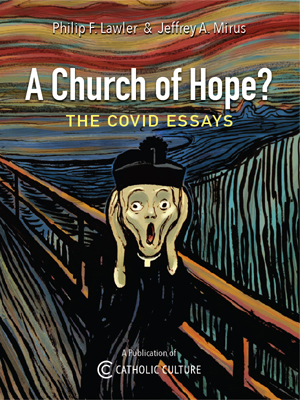The Feast Goes On
As a new parent, I was flummoxed by how to explain Jesus to a two-year-old. The church year answered my question. You start by letting her participate in the story: By letting her see the crèche at the front of the church during Advent and the Wise Men moving toward it during Epiphany. By standing with her in a candle-lit church on Christmas Eve. By having her forehead crossed with ashes at the beginning of Lent. By giving her a palm frond to wave on Palm Sunday. By giving her a bell to ring on Easter Sunday. By wearing red on Pentecost. The church year was made for people like her.
Ascension Day last year found my husband and me, each with a toddler on his back, hiking up a local hill to remember how Jesus went up into heaven. We know of families who tend Michaelmas daisies for the feast of angels and pick shamrocks on Trinity Sunday. During Pentecost, some people decorate their tables with red rose petals, to remember how the Holy Spirit descended with tongues of flame. The saints' days also offer chances to participate in the story, by folding reed crosses on St. Brigid's day, for example, or packing up food to give to the poor on St. Stephen's.
In years past, you could tell a Christian home the moment you entered it. From Advent candles to Epiphany markings on the door, physical reminders of the Gospel story tied to the church year were present in such homes throughout the year.
The Homemaker's Year
When it comes to celebrating the church year, the next best thing to being a priest, monk, or nun is to be a homemaker. No other vocation provides so many opportunities to observe the church year in daily life.
For example, as a mother, my day now revolves around food in a way it never did before. Since I must make sure four people are fed three meals a day, I think about food from when I get up in the morning to when I go to bed at night. I must make sure that the meat is defrosted, the pantry is full, the vegetables are gathered from the garden, washed, and chopped.
Food has a seasonal cycle: A good steward will not waste the household's money by buying strawberries in the winter or asparagus out of season. With the church year, there is even more to seasonal food than considering what is ripe when: There are special foods for Christmas, foods for Easter, foods for Pentecost. There are pancakes on Shrove Tuesday. There are hot cross buns and lamb in the spring. There are Lenten pretzels and vegetable soups. There is angel food cake for Michaelmas and king's cake for Epiphany.
The changing of the seasons gives a rhythm and meaning to even the prosaic task of getting dinner on the table every night. Snap peas in the garden in spring become a reminder that Christ is risen, and risen indeed. And as my children are present with me while I do all of this kitchen and garden work, I can tell them why we are cooking what we are cooking that day, and so preparing meals becomes a chance to talk with them about Jesus.
As with the food I prepare, all the traditions of the church year turn the ordinary work of my vocation into a daily reminder of the gospel. The life of a stay-at-home mother is derided by many as repetitive and boring, but what those critics do not realize is that the repetition is not rote, it is rhythmic.
It is not like being a cog in a factory but like providing the structure of a hymn. In The Screwtape Letters, C. S. Lewis's demon narrator takes note of this divine gift of the pattern of change and permanence. God "has made change pleasurable to them, just as He has made eating pleasurable," he tells his nephew Wormwood.
But since He does not wish them to make change, any more than eating, an end in itself, He has balanced the love of change in them by a love of permanence. He has contrived to gratify both tastes together in the very world He has made, by that union of change and permanence we call Rhythm.
God gives them seasons, he continues, "each season different yet every year the same, so that spring is always felt as a novelty yet always as the recurrence of an immemorial theme. He gives them in His Church a spiritual year; they change from a fast to a feast, but it is the same feast as before."
Like the structured day of work and prayer found in a monastery, the structure of the church year turns homemaking also into a pattern of work and prayer.
Comforting Presence
A friend once told me that she was comforted by the existence of monasteries; she knew that though she was not praying every hour of the day, there was always, somewhere in the world, someone petitioning God to remember his mercy to his creation. I know that my husband, as he works to provide for us, does not have the freedom that I do to be continually thinking of the story of Advent or Christmas or Epiphany, or Lent or Easter or Ascension or Pentecost.
But when I am caring for our home with an awareness of these things, he and our children soak it in, too. I don't celebrate the church year for myself alone, but for my family, who live in the home that I make.
This item 8309 digitally provided courtesy of CatholicCulture.org






